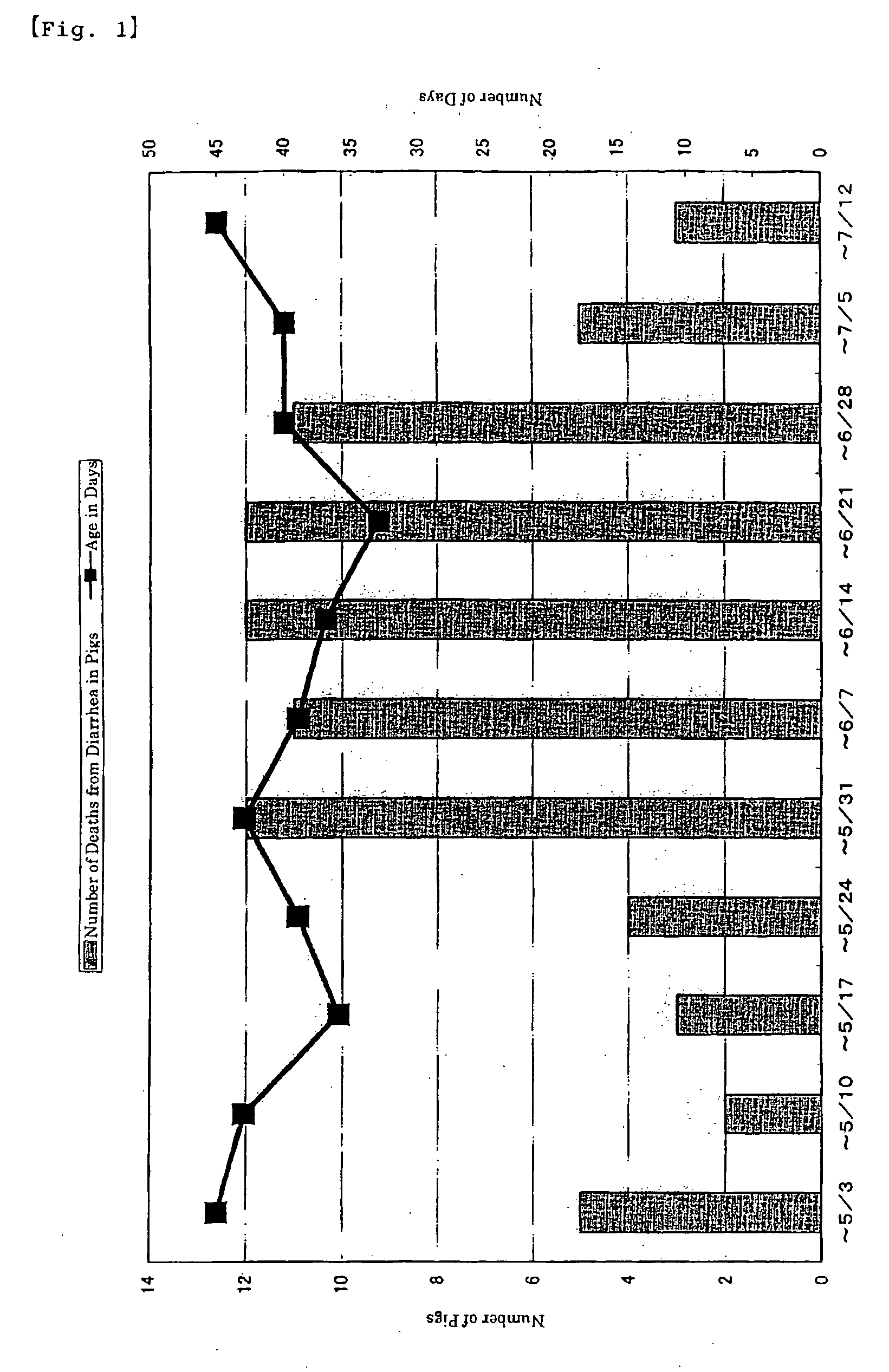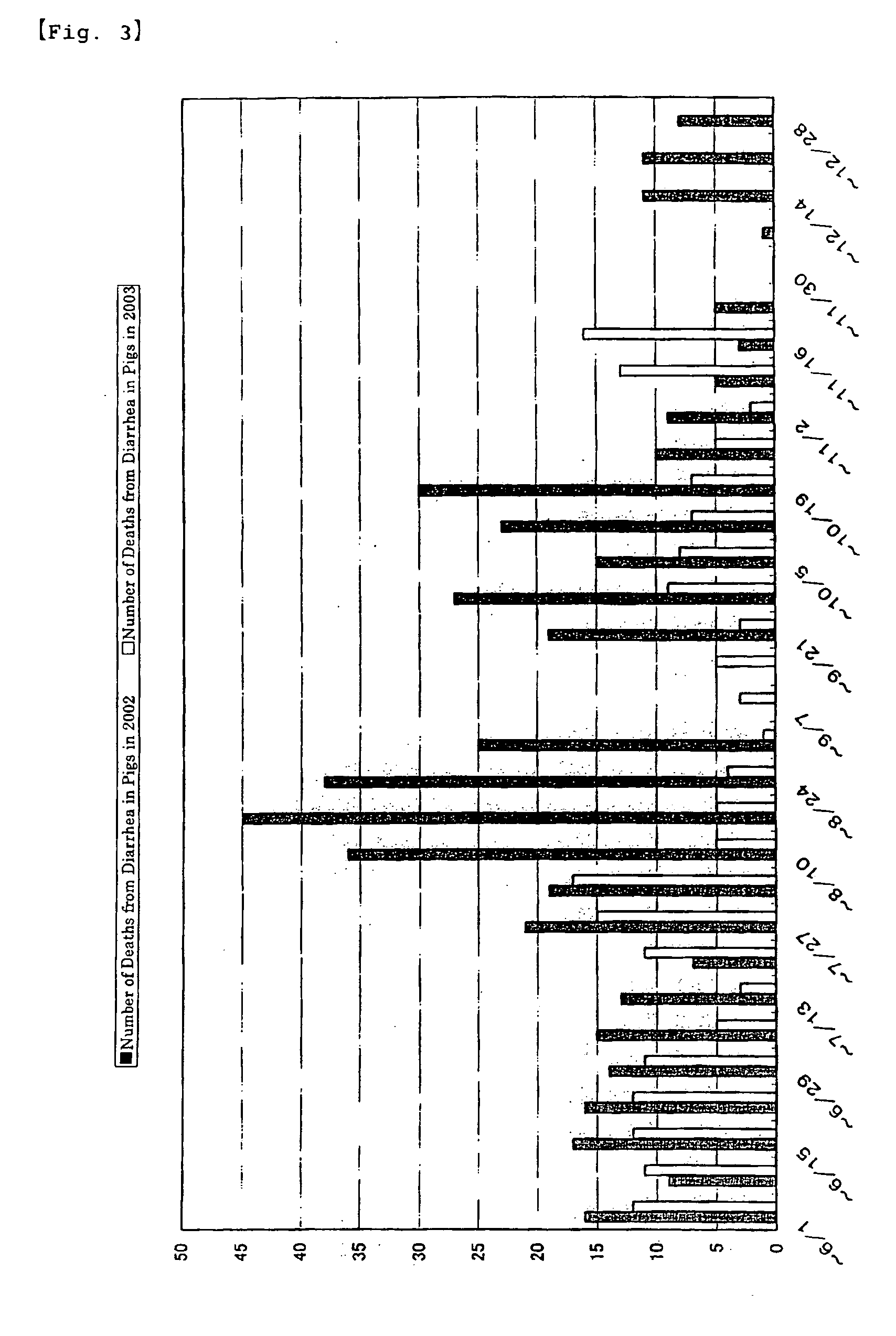Antidiarrheal agent for livestock and poultry
a technology of antidiarrheal agent and livestock, which is applied in the field of antidiarrheal agent, can solve the problems of abnormal large-intestinal flora, dyspeptic diarrhea of piglets and sows, and insufficient secretion of digestive enzyme and gastric acid, so as to achieve effective antidiarrheal effect and suppress diarrhea
- Summary
- Abstract
- Description
- Claims
- Application Information
AI Technical Summary
Benefits of technology
Problems solved by technology
Method used
Image
Examples
example 1
Culturing and Preparation of Bacteria
[0032]Enterococcus faecalis EC-12 (FERM ABP-10284) was cultured in a Rogosa medium at 37° C. for 24 hours. The preculture solution was inoculated in a amount of 0.1 (v / v) % to a liquid medium which contains 4% yeast extract, 3% polypepton, and 10% lactose. By adjusting the pH to 6.8-7.0 with sodium hydroxide solution by using a pH stat, a neutralizing culture was conducted at 37° C. for 22-24 hours.
[0033] After the culturing was completed, the bacteria were separated with a continuous centrifuge and collected. Then, water was added to dilute up to the original liquid level, and the bacteria were separated again with a continuous centrifuge and then collected. This operation was repeated 4 times to wash the bacteria. Subsequently, the washed bacteria were suspended in an appropriate amount of water. The bacteria were then sterilized at 100° C. for 30 min and dried by using a spray drier to prepare powder of heat-killed bacteria.
example 2
Identification of Pathogenesis Factors and Clinical Scores
1. Test Feed / Test Animals / Growing Method
[0034] Dried killed bacteria (hereinafter referred to as “EC-12”) obtained in Example 1 was diluted 10-fold with flour to make a premix in advance. Thereafter, the premix was added to basic feed SDS No. 1 (without antibacterial agent or live-bacterial agent, Nippon Formula Feed Manufacturing Co., Ltd.) so that the feed to be used contains 0.05% EC-12. As a control feed, the basic feed which was added 0.5% commercially available flour was used. As for test animals, the subjects were 31 (4 broods) suckling piglets (LWD-strain three-way-crossed pigs) with diarrheal symptom. The suckling piglets were grown in pig farms where diarrhea had frequently occurred in suckling and weaning piglets. The suckling piglets were 18-24 days old and were grown with sows in the farrowing stall. The piglets fed only on breast-milk. The group with EC-12 administration was weaned 4 or 8 days after starting ...
example 3
Decrease in the Number of Deaths in Piglets
3.1. Test Scheme
[0047] The test farm raises 400 sows under a coherent management. It has open-type pig-houses as farrowing houses as well as windless pig-houses as weaning houses. The test farm implements all-in / all-out system. From the start of feeding until day 7 after weaning, piglets of 5-33 days old were administered EC-12 by mixing it in the feed. Other test conditions were the same as those in Example 2. The administration of 100 mg per kg of body weight of EC-12 was started on Jun. 22, 2002. The administration was continued until Jul. 18, 2002. The dosage was reduced by half from Jul. 19, 2002 and 50 mg per kg of body weight was administered until Aug. 2, 2002. Then from Aug. 3, 2002, the dosage was returned to the original amount and 100 mg per kg of body weight was administered until Sep. 27, 2002. Subsequently, the dosage was doubled and 200 mg per kg of body weight was administered until December 2003.
3.2. Administration Ef...
PUM
| Property | Measurement | Unit |
|---|---|---|
| period of time | aaaaa | aaaaa |
| v/v | aaaaa | aaaaa |
| v/v | aaaaa | aaaaa |
Abstract
Description
Claims
Application Information
 Login to View More
Login to View More - Generate Ideas
- Intellectual Property
- Life Sciences
- Materials
- Tech Scout
- Unparalleled Data Quality
- Higher Quality Content
- 60% Fewer Hallucinations
Browse by: Latest US Patents, China's latest patents, Technical Efficacy Thesaurus, Application Domain, Technology Topic, Popular Technical Reports.
© 2025 PatSnap. All rights reserved.Legal|Privacy policy|Modern Slavery Act Transparency Statement|Sitemap|About US| Contact US: help@patsnap.com



